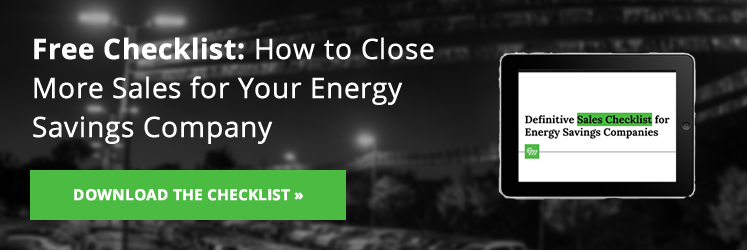Selling energy efficiency should be easy right? Who does not want to save energy and thus save money? Everyone wants to reduce their carbon footprint, and businesses want to save money and improve their profitability. The savings are obvious and the technology is proven. Why, then, are substantial energy projects so hard to get sold and implemented?
If you are in the energy savings business you have likely been through the following senario:
It’s Monday morning and you get in the office and pour your first cup of coffee and fire up your laptop. Your crack Marketing department has delivered your list of weekly leads that came in on your website. You peruse the list to see what new opportunities might be worth pursuing and come across one that looks promising. The facilities engineer from a major aerospace parts manufacturing plant less than thirty miles away has downloaded your company whitepaper on how he can save money by upgrading his facility to LED lighting. You are familiar with this facility as you have driven by it many times and it has to have close to a million square feet under roof but you have never stopped in not knowing where to even begin to do business with them. Your first instinct is to send an e-mail with your company information and an LED lighting case study, but you are feeling aggressive as the caffeine from your second cup of coffee kicks in so you opt for the direct approach and pick up the phone and make the call to the direct line listed. Bingo, your contact picks up the phone and you introduce yourself and after some warm up conversation you launch into your elevator speech. Amazingly the facilities engineer actually has some personality and engages into the conversation, you find common ground on the LED subject and actually find out you both attended the same university across town. The meeting is set up for later in the week and you are excited for what sounds like a great opportunity.
The meeting day comes and things go very well, the engineer understands the technology gives you a tour of the facility and he agrees to your suggested next step of doing a complete energy audit. You of course asked to be paid for this but he has no budget. After seeing the older lighting in place and finding out this facility runs 24/7 you know the ROI will be good and this will be a no-brainer sale so you agree to bring your team in and spend a day on the free audit.
The Greatest Challenge in Selling Energy Projects
This sounds like a dream scenario, but, although fairly common, our ESCO (energy savings company) salesperson has made a major mistake. They forgot to ask a simple, but important, question. IS THIS PROJECT BUDGETED AND FUNDED? While our sales person is hard working and enthusiastic, without addressing this issue first he/she is about to waste a lot of their time, and your companies time, on a project that may never be considered. Obviously each situation is different as to why energy projects do not close and get implemented, but 80% of the time it is due to not having budgeted funds.
To overcome this challenge, we have detailed a three step process to help you successfully close your energy efficiency projects.
The Three Step Process to Selling Energy Projects
1. Ask about the budgeting or funding of the energy saving project.
If the answer to whether or not there is a budget or funding available is yes, then proceed to step three. If the answer is "I don’t know" or "not yet", then you have some work to do. First, identify the person that allocates funding. If you are dealing with a small business, it is usually the business owner. If it is an industrial facility, it may be the plant manager. In most cases, a good place to start is the CFO, or Chief Financial Officer, of the company. If you cannot identify and reach the person who controls funding, chances are you are wasting your time and need to move on. ESCO salespeople do not want to hear this. They are very good at generating comprehensive business audits, with complete professional 50 page proposals detailing the complete business case, implementation strategy, and all the reasons why this project is a no-brainer. This consumes countless hours of their time and the time of your proposal and marketing departments. Although major efforts are conducted, it is all for naught if the funding has not been allocated.
2. Make the case for funding to be allocated to an energy efficiency project.
That sounds simple enough, right? It actually can be, and, most often, the simpler the better. Once you identify the stakeholder who holds the purse strings, it is helpful to learn what their benchmark is for a project to be approved. Typically, most companies will have an ROI benchmark, say, under two years before they will evaluate and consider a major capital expenditure. It is now as simple as preparing a one page financial analysis that needs three key pieces of information.
One is ROI, or return on investment, in terms of how long will it take to capture the initial investment. If the project costs $500,000 to implement and it generates $300,000 dollars in savings, simple ROI is $500,000/$300,000 will generate a simple ROI of 1.67 years. The second piece of key information is IRR, or internal rate of return. The IRR of an investment is the discount rate at which the net present value of costs (negative cash flows) of the investment equals the net present value of the benefits (positive cash flows) of the investment. If the IRR is greater than the company’s cost of capital, the CFO is likely to consider this as a project which should be approved. The third piece of our one page financial analysis is a multi-year cash flow analysis over the life of the project, which can usually be plotted out in a simple bar graph.
A complete energy audit is not necessary to get these rough numbers, as it may be as simply asking our facilities engineer these simple questions. How many light fixtures are in the factory? What is their wattage? What is your electricity cost? How many hours per day are they lit? How much does it cost to replace a fixture? How often are the lights replaced?
At this point it is important to make sure that there are no objections, with the most common one being the large up front cash outlay that may be required. If this is an objection, you must overcome it by offering financing. This may be in the form of you doing the financing, third party financing, PACE (Property Assessed Clean Energy), or performance based contracting.
Once the one page CFO financial analysis is prepared, then it will be time to get the commitment for them to pay for your complete facility energy audit. This is very important to secure this commitment, and some ESCO’s will credit the audit feedback if the total energy savings project is awarded to the said ESCO.
3. Sell yourself.
Now that the CFO is convinced he has a viable project financially and is excited to move forward, it is imperative that they move forward with you! Just because this was your idea does not mean you have won the project. Obviously you have the inside track if they contract you for the audit, and there should be some inherent loyalty as you are working closely with them to help them save money and improve their profitability. You must establish credibility and convince the customer you have the experience and ability to provide them good value with the project management and implementation.
Here are several powerful methods to ensure you are the chosen provider.
First, present case studies and references. Documented case studies are powerful, and help the customer understand that this is not your first rodeo and that you have good experience working with customers that are similar to him. It is also recommended that you provide a reference list of contacts that the customer can contact directly to understand how well their project was implemented and the subsequent results.
Secondly, take them on a tour of an installation, seeing is believing! This has the added benefit of showing them how much better lighting can be with LED technology. They should be given some one on one alone time with your customer showpiece so they can ask frank questions to an independent third party.
Finally, guarantee the project. If there are any reservations about your promises of energy savings that you have presented, this should dispel them. You should be able to easily present a conservative guarantee and demonstrate these savings. This documentation further assures the CFO that he will be able to go to his boss after the project and demonstrate the success of the project. There may be other company divisions that will also want to have their own energy projects based on this documented successful cost savings and profit improvements.
In conclusion, it is important to focus on the key factor in getting a successful energy project moving forward, and that is the budgeted funds that need to be allocated. These funds, for any substantial projects, are allocated almost always by the CFO or CEO. You must present the financial argument in their terms and gain their buy in before you really have a project to work on.

